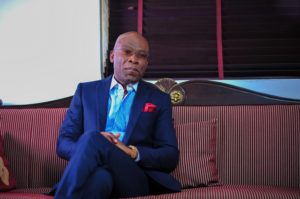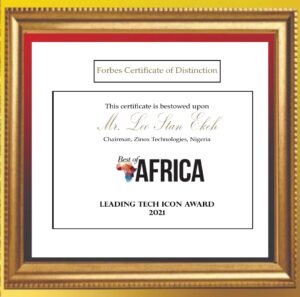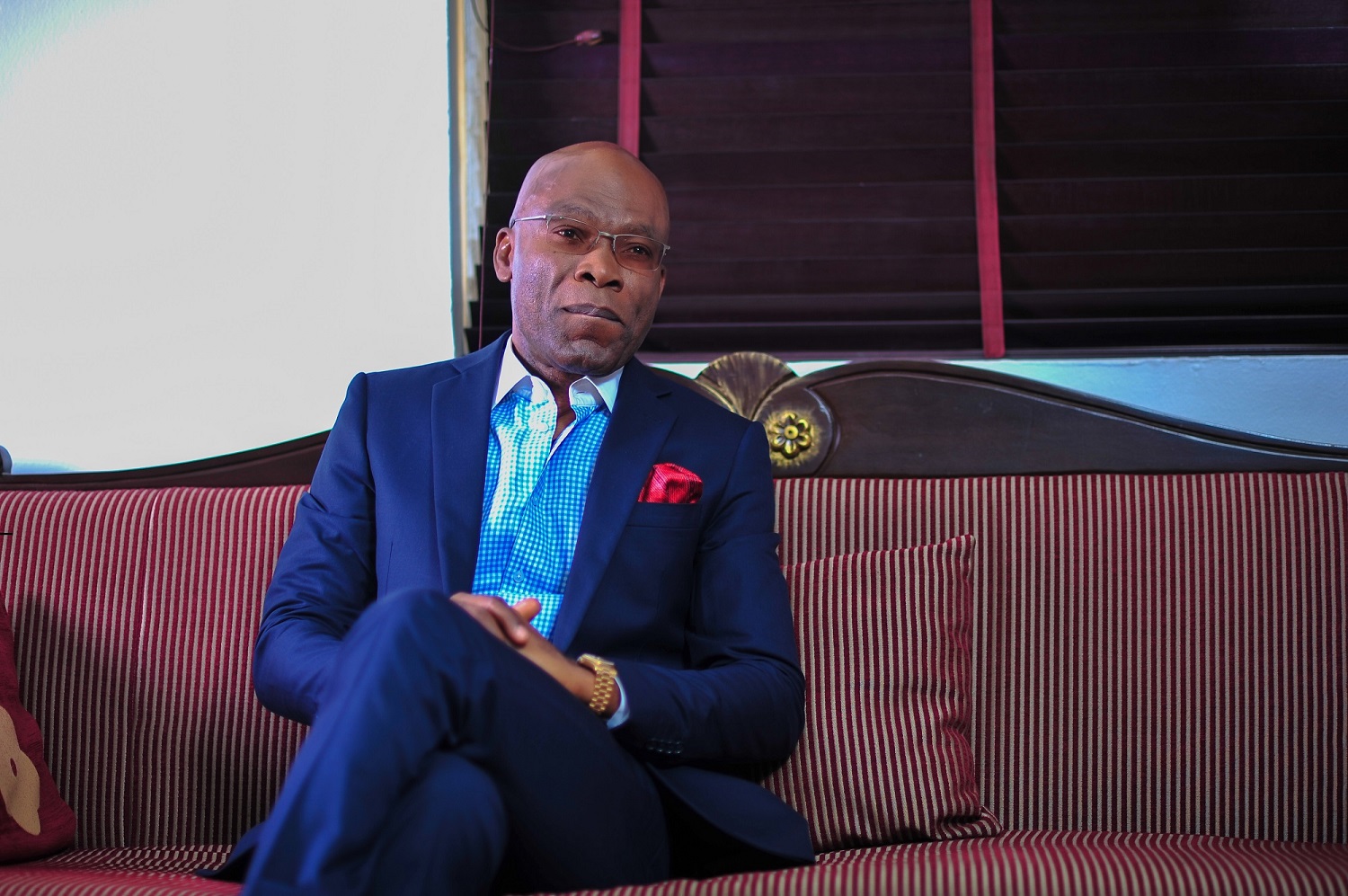Leo Stan Ekeh as Forbes Best Tech Icon in Africa
August 22, 2021
By 2001, he took his adventure in the computer world to its Holy Grail: Full assembly of internationally certified computer brands, Zinox, the first indigenous computer to earn both Intel and Microsoft certification. Forbes more than any other consideration must have paid special attention to the history and trajectory of the Zinox brand as a true African ICT identity

The recent conferment of the Forbes Best of Africa Leading Tech Icon Award on Leo Stan Ekeh is far more than a personal honour for Africa’s most versatile serial digital entrepreneur. It’s a recognition of Nigeria’s unassailable position on the continent’s Information Communications Technology, ICT, firmament. It indexes Nigeria’s march from the backwaters of technology to global reckoning.
In the 70s up to the 80s, Nigeria was not on the global digital economy map. Computers were rarely seen in offices, let alone homes. The nation was immersed in the culture of analogue typewriter, that chattering, noisy contraption that held up some ‘magical’ aura back in the day. In the advanced climes, desktop computers from IBM and Apple were taking up strategic places in offices. They were wiping out the last memories of the IBM mainframe, the big, bulky machine that occupied more space in the office than the file cabinets.

In publishing, the analogue Compugraphic machine, once regarded as the golden gift to publishers, was at its terminal term on planet earth. Nigeria, and indeed Africa, was still one tiny black dot in the global tech map. Africa was waiting for a miracle. Nigeria was waiting for his own: a young, energetic Afro-wearing graduate returning to his country after successful academic voyage in India and the United Kingdom. Leo Stan’s arrival in Nigeria in the 80s changed the landscape. He had his brief: to venture into infotech business. He considered not the oil and gas sector where you could easily make cheap, sometimes slush money. He fancied not real estate and construction. He kept his eyes on the ball he has set before him: ICT, after having been fired up by a chance meeting with the late Apple founder, Steve Jobs, in the UK.
It’s instructive that he started with Apple upon his return to Nigeria. And over the years, Leo Stan has all by himself pioneered many digital ventures and widened the frontiers ICT in Africa.
Forbes cited his multiple pioneering roles and sustained expansion of the continent’s ICT ecosystem through a period of over 30 years as reasons for the recognition. The influence of his multiple ICT initiatives from computer (hardware and software) to telecoms spreads through four continents.
His strength is his ability to see beyond the moment, to anticipate the future, identify opportunities even in disappointments and spring solution to challenges. Forbes recognised his pioneering roles in e-Commerce, Desktop Publishing and Computer Graphics, Wireless Cloud and WiMAX (Worldwide Interoperability for Microwave Access), a telecoms technology genre that enables the transmission of wireless data over long distances usually from point-to-point links to full mobile cellular type access. Don’t be terrified by the jargon. WIMAX is simply WiFi over a large area – a city, state, etc. He landed the first hub in Yobe State in 2007, launched by then Minister of State for Information and Communication, Alhaji Dasuki Nakande.
He did much more. By 2001, he took his adventure in the computer world to its Holy Grail: Full assembly of internationally certified computer brands, Zinox, the first indigenous computer to earn both Intel and Microsoft certification. Forbes more than any other consideration must have paid special attention to the history and trajectory of the Zinox brand as a true African ICT identity.
Within less than a decade after the first batches rolled out of the assembly plant, Zinox assumed a fully integrated digital life of its own with desktops, laptops, and sundry handhelds making up its bouquet of products. And far more than that, the Zinox brand became both the desired and the preferred not only in schools, corporate environments but also as the chief driver and tech power of major pan-African events held in Nigeria and offshore.
A few instances. Between October 5 and 17, 2003, Nigeria hosted the 8th All Africa Games codenamed COJA 2003. It was powered by Zinox among other tech brands.
Also between December 5 and 8, 2003 when Nigeria hosted the 18th Commonwealth Heads of Government Meeting (CHOGM), the incumbent President Olusegun Obasanjo, a huge fan of Zinox brand, opted for Zinox products to power the summit. Trust President Obasanjo and his pan-Nigerianism, he did not fail to tell the vising heads of government about the Nigerianness of the computer brand on display. Fat-track a little. From April 17 to 22, 2004, hundreds of athletes from no fewer than 15 African countries gathered in Bauchi, North East Nigeria. The event was the All-Africa University Games, a regional multi-sport event organised for the continent’s university athletes by the African University Sports Federation (FASU). Zinox was there to power the event.
Banjul, capital of The Gambia played host to the 7th Ordinary Session of the Assembly of the Africa Union (AU). The event which held from July 2 to 5 was powered by Nigeria’s Zinox with over 50 African heads of government attending.
Perhaps, organisers of the Forbes awards may have seen through the prism of innovation and strategic thinking how Leo Stan pioneered the entry of digital dispensing pumps for fuel and gas stations across the country. Even this has its peculiar story, the story of an entrepreneur who after being cheated by a filling station attendant using analogue dispenser, turned the misfortune to fortune. It’s a story for another day but it drips with the moral: There’s a silver lining in every dark cloud.
I wager, too, that Forbes may have considered the role he played in Nigeria’s electoral process using the instrument of ICT. It’s to his credit that Nigeria is today at the juncture of e-transmission of election result. This is a later part of a process that commenced in 2006 ahead of the 2007 election when INEC embraced the Direct Data Capture, DDC, machine which helped to clean up the voter register. He delivered 11,500 DDC machines in 14 days.
Before then, the voter register was a mixed bag of the absurd, the ugly and the good. Exotic names like Mike Tyson, Michael Jackson and many phoney names made up significant portion of the voter register. The DDC machines helped to clean the mess. Leo Stan played a leading role in the configuration, calibration and deployment of these machine. Patriotism!
He would top it up with the introduction of the card reader units especially in the 2011 general elections when he pulled a stunt that even the multinationals involved in the same project could not match. This time, he delivered 80,000 fully integrated units of DDC machines within 35 days ahead of two foreign companies in time enough for the conduct of the general elections of that year to the relief of then INEC chairman, Professor Attahiru Jega.
Leo Stan, a computer science post-graduate dropout has broken limits in the complex computer marketplace, once a monopoly of the Western world. He demystified computers and computing, building ICT training hubs across Nigerian tertiary institutions in an ambitious project codenamed Computerise Nigeria Initiative. And because of this, young Nigerians have transformed to nerds and geeks in the global geekdom. Leo Stan laid the foundation. And it’s of no wonder that Forbes, the globally acknowledged media barometer for measuring excellence, has found him worthy of this honour. He deserves it!
Author: Ken Ugbechie
First published in Sunday Sun







